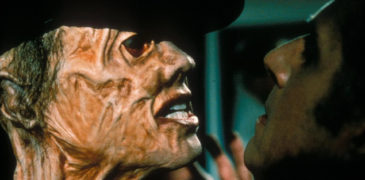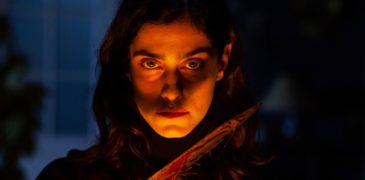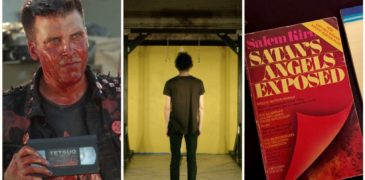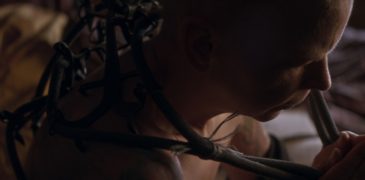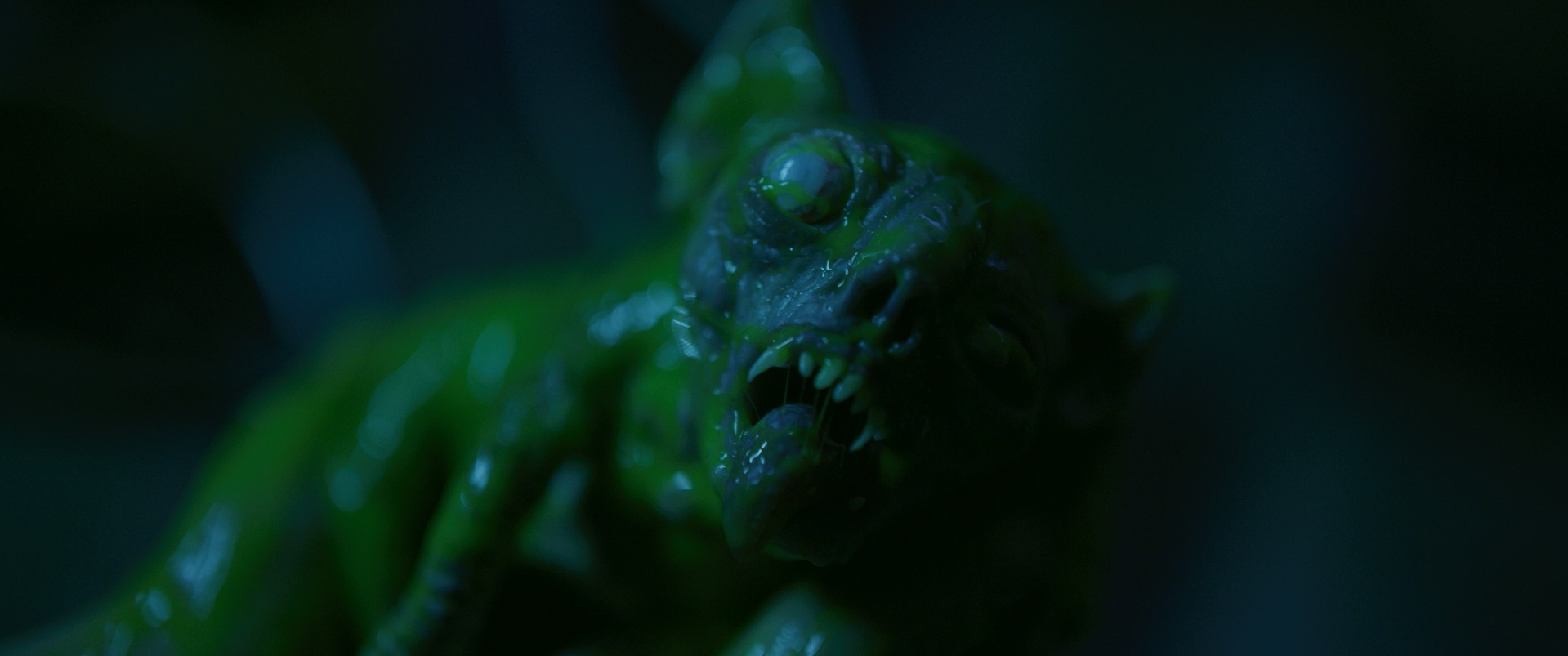
Toronto After Dark Film Festival describes Isaac Ezban’s latest as “possibly the scariest film in [their] lineup this year,” and it is not difficult to see why. Balancing storybook wonder with Gothic horror, Evil Eye (or Mal de ojo) is a mesmerizing film about witchcraft, abuse, and femininity. Bolstered by some incredible performances and gruesome special effects, the film is set to be one of the most exciting releases of the year. The plot concerns preteen Nala (a fabulous Paola Miguel) who comes to stay with her estranged grandmother, Josefa (Ofelia Medina), in the country. Her younger sister, Luna (Ivanna Sofía Ferro), is dying, and their parents no longer trust doctors and hospitals to help her. After learning a local legend of dark magic, Nala begins to suspect that her grandmother may have something in common with the witch in the story.
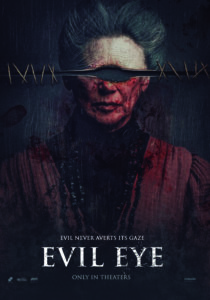
After a fairytale opening, Evil Eye switches to a contemporary setting and introduces us to our protagonist, Nala. Paola Miguel offers a nuanced performance as the distant, neglected elder daughter. Her sister’s illness dominates her parents’ time and attention, leaving Nala to her own devices. Trying to balance the fear of losing Luna with attempts to have a normal life has taken its toll on Nala; she is at times defiant and cold, pushing back against her mother’s wishes. As the film goes on, however, she naturally falls into the role of a protective older sister. Life with well-meaning but neglectful parents does little to prepare her for the emotional manipulation that awaits in grandma’s house. Miguel’s nonverbal acting is a strength, her face contorting into horror and disgust, confusion and determination. These silences bolster the power of emotional outbursts, which feel natural and deeply honest.
Early on, Nala says that she could write a list of all the mistakes her mother has made. When she meets Josefa, the reason for her poor parenting becomes clear. Hunched over a walking stick and crooning passive-aggressive comments, Ofelia Medina is instantly hateful in the role. Left alone with the children, emotional abuse soon turns physical. Medina’s presence alone injects a sense of dread and a threat of danger; she immediately puts us on edge. Even her dedication to Luna’s health and well-being is suspicious. Her unpredictable behaviour and infrequent displays of physical strength belie her advanced years. While she is positioned as the villain almost as soon as she appears, the performance is so compelling and inventive that we cannot wait to see her unmasked.
Based on an original script by Junior Rosario, Evil Eye sows sinister seeds from the very beginning. Lines that already make sense in context gain deeper meaning once the credits start to roll. The structure is not always tight – a final scene, allowing Nala a realization the audience already gained in the climactic sequence, forces allegory into reality – but the narrative is always compelling. Witchcraft as a metaphor for coming of age and womanhood is not uncommon ground in horror. Evil Eye manages to pay tribute to what has come before and offer something new. Decorator Mara Ugalde worked in collaboration with art coordinator Edgar García to create a sumptuous, Gothic set. Isi Sarfati’s cinematography finds yellows and pinks and greens, heightening the storybook feel in daylight. Nighttime in the house is blue and silver, dreamlike. Then Nala grabs a lantern in a dark room; the sudden realism of this one action highlights the very real danger.
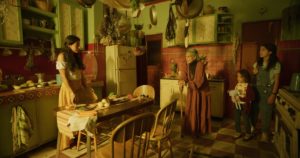
Like many horror films, Evil Eye leans a little too heavily on loud jump scares. Like Josefa’s walking stick, it becomes clear that there is no need for them. Once the film settles into a rhythm, scares are more organic and better choreographed. Ezban overtly references a number of horror films here. The family car, shot from above, winds its way into the countryside accompanied by a Dies irae-inspired score (The Shining, 1980). Trapped in the basement and cast in an eerie green hue, Nala briefly faces the wall (The Blair Witch Project, 1999). It could be argued, then, that Izban employs loud scares as an acknowledgment of where horror is now, before challenging it. Loud scares prepare us for disappointment; animatronics and practical gore effects (overseen by Roberto Ortiz) pleasantly surprise us.
Evil Eye is not a perfect film, but any shortcomings are easily forgiven and soon forgotten. Ezban wears his influences on his sleeve, so the film feels familiar but never contrived. Comparisons to other Spanish-language dark fairytales like Pan’s Labyrinth are perhaps inevitable, but Evil Eye is distinct enough to stand alone. It interweaves a Grimm Brothers-style fairytale with a realistic story of abuse and familial responsibility, never missing a beat. A consistent aesthetic vision, practical effects, and strong performances combine to make Evil Eye a new favourite.
We watched Evil Eye as part of the Toronto After Dark Film Festival 2022.
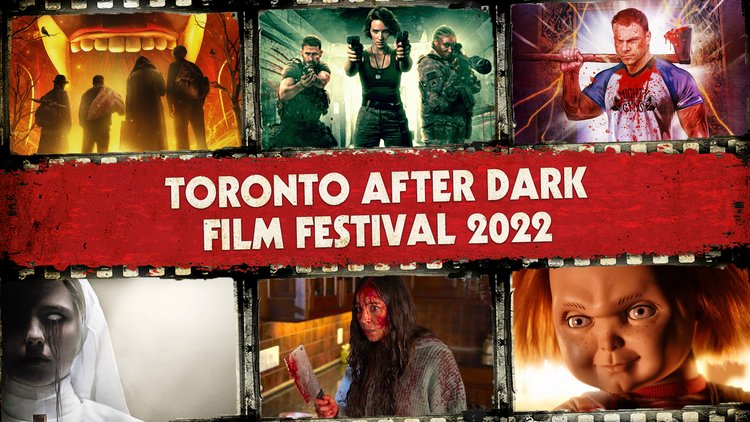
More Festival Coverage
Traumatised from witnessing the horrific death of her parents, Sara attempts to take her own life. Waking up in the aftermath of this, she cannot remember anything and does her… When I watch a horror movie from the 80’s, I inevitably have the thought of “how the hell did this movie get made?” Don’t get me wrong, there are some… Selected to cap off the closing night of Fright Fest 2021, The Advent Calendar has come to the attention of horror fans as one of the titles already announced as… Writer/director and the founder and artistic director of monochrom, Johannes Grenzfurthner is one of the most unique voices in cinema today. We were lucky enough to catch both Masking Threshold… Bringing you more found footage and POV horror than you can shake a stick at, Unnamed Footage Festival is back at it once again with an incredible lineup for 2023…. “Every day we stray further from God’s light” may be a ‘meme-able’ saying, but it is one that is none-the-less true when we look at a mix of contempt and…The Free Fall (2021) Film Review – Dreams, Gaslighting, or Something Sinister?
Phantom Of The Mall: Eric’s Revenge (1989) Film Review – Remastered Slasher For FrightFest
The Advent Calendar Film Review – Eat Chocolate or Die!
Interview with Filmmaker, Writer, Artist and Performer Johannes Grenzfurthner
Unnamed Footage Festival 666 (2023) Short Films Collection- A Short, Sharp Shock to the System
Luzifer (2021) Film Review – Religious Fervor and Unforgiving Isolation
Isabelle is a writer from the UK who enjoys alternative manga and horror films. When not writing, you can probably find Isabelle buying books or obsessing over Martin and Lewis.

